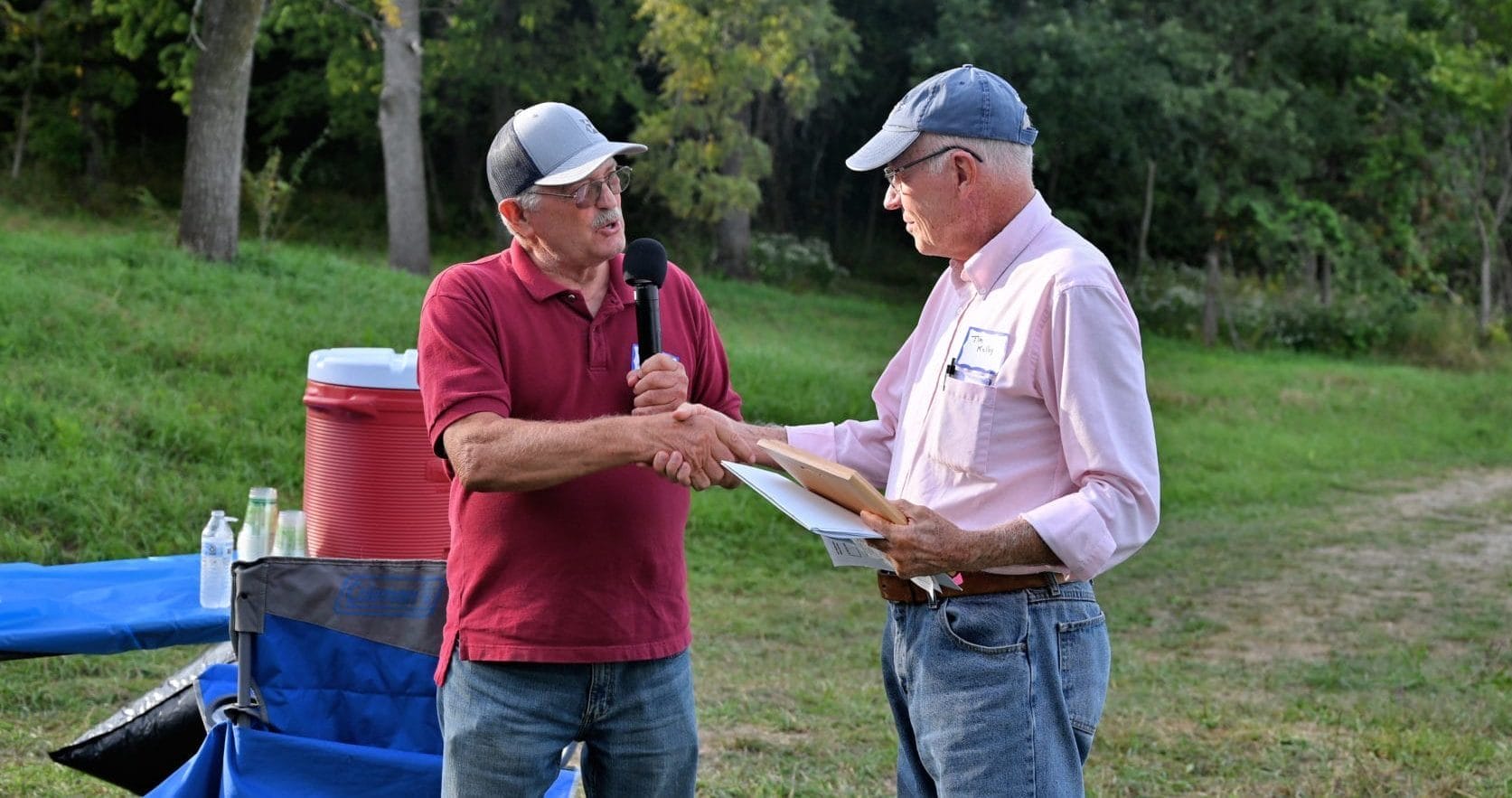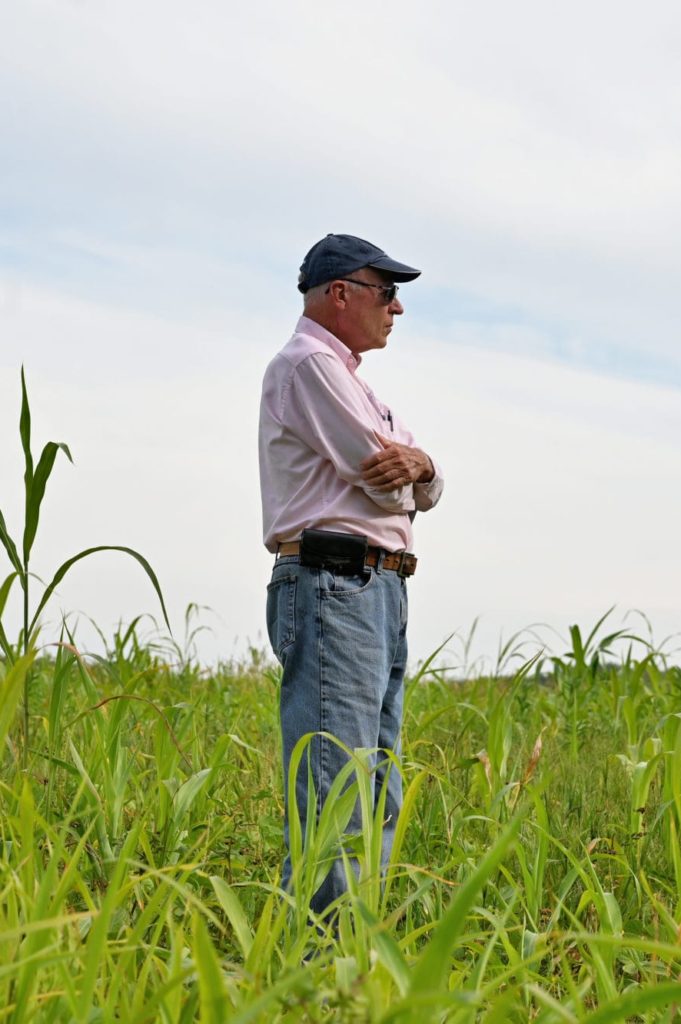Treating the Land Right
A desire to leave his land better for the future has guided Tim Kelley’s 30-year journey to steward his soil.
On a sunny mid-September evening, 34 attendees took their seats on Tim Kelley’s farm in Elmo, Missouri. Sorghum sudangrass, still summery in its lush green, sprouted from a nearby field of cover and forage crops.
Along the adjacent edge line, a thick canopy of trees cast a cooling shade over the diverse array of plant life – and the assembled crowd – as longtime PFI member Ron Rosmann awarded Tim with PFI’s 2024 Farmland Owner Achievement Award.
Tim and his sister, Margaret Kelley, co-own about 800 acres along the Nodaway River in northwestern Missouri. Tim’s tenant, Brent Nold, raises corn, soybeans, small grains and multispecies cover crops on 400 of those acres.
Another 140 acres is dedicated to warm- and cool-season grasses that, until 2022, held cattle. The rest of the acreage contains cool-season grassed headlands, filter strips, woodlands, smaller prairie and pollinator areas and a recently restored oxbow.
Practical Farmers of Iowa created the Farmland Owner Legacy Award in 2013 to recognize landowners who help the next generation get started, advance land stewardship and promote long-term sustainability of farm businesses, environmental quality and rural communities.
Tim, while grateful to spread awareness of what he’s working on, posits that he’s not alone in these efforts. “There are plenty of people that are doing the same and more,” he says.
Livestock and the Land
Tim’s grandfather purchased the first parcel of the Kelley farm in 1907, making it a Missouri century farm. Tim grew up on the farm with his siblings, Sam and Margaret. He was fully immersed in farming life, from daily chores to raising livestock through 4-H. At 18, he left for college and spent eight years exploring the world outside of farming. Twelve years after he left the farm, he returned.
Although he grew up on the farm, Tim had never made decisions for the operation. He began farming 400 acres with a typical conventional row crop and livestock setup, but it did not yield what he had hoped, especially with the equipment cost. Tim grew curious about changes he could make, and in the late 1980s, after a drought, he added warm-season native grasses and began amending his livestock management.
“There had always been cattle, but I started intensifying the management,” Tim says. Until then, cattle had been allowed to openly graze large areas, spending eight to nine months on grass and then crop residue during the winter.
Tim also built fences between sections of pasture to let them rest, added multiple paddocks and installed underground waterlines. While the soil and forage improved, it wasn’t until he initiated high-stock-density grazing that he saw more rapid improvements. With this approach, cattle are rotated often to different pastures, which encourages more efficient grazing and gives plants more time to rest and recover. His journey to improve his soil health began in earnest in 2000.
“The more I learned,” he says, “it seemed obvious that [conservation] was the right thing to do.”
Over the years, Tim has become an expert on livestock management, especially as a means of preserving and improving soil organic matter. In 2003, he took part in a SARE research project that aimed to control forbs typically considered undesirable with multispecies grazing (Tim notes that with high-density grazing, all forbs have value as food for livestock or the “microbiological ecosystem”).
At that point, he was grazing cow-calf, stocker and sheep herds on 150 acres of diversified grass and legume pasture. Even in a drought year, Tim says multispecies grazing effectively reduced weed pressure in the fields, affirming his approach – and his belief that he was on the right path.
In 2016, PFI staff interviewed Tim for a member spotlight. He’d been using soil-health practices for nearly 20 years and had begun using Haney soil tests to assess his progress.
In that interview, Tim shared that high-density grazing had helped boost organic matter on one of his properties to 7%. “It’s pre-settlement levels for northwest Missouri or southwest Iowa – 6-8% is what they think the prairie had,” Tim says.
Through careful observation and yearly testing, Tim found that while organic matter either held steady or dropped in his row crops, the cool- and warm-season grasses and legumes improved his soil health.
As he transitioned from farm operator to non-operating landowner, he worked with each tenant to incorporate soil health practices. In 2023, he found Brent Nold through mutual acquaintances, and the two work closely to nurture the land through their shared vision.

Ron Rosmann presents PFI’s 2024 Farmland Owner Legacy Award to Tim Kelley during a field day on Sept. 13, 2024.
Partners in Preservation
Since Brent took over as tenant, he and Tim have pushed the envelope on row cropping, with a focus on maximum diversity. They have been working to bring small grains back to the farm and introduced a 14-species mix of cover crops following small grains as well as preceding and following the corn and soy rotations. Brent is adding poultry litter and other organic material to increase soil health.
When nominations opened for PFI’s Farmland Owner Legacy Award, Brent nominated Tim, citing Tim’s financial and moral support for stewardship practices.
“[Tim] is discounting the rent for soil health practices and is always pushing me forward down my soil health journey,” Brent says. “Living roots year-round is a goal we are accomplishing as well.”
“Nature hates a vacuum, but also abhors a monoculture,” Tim says. “That’s why we like multispecies in our pasture – both above and below ground.”
The only piece missing from their system is livestock. Tim was the grazier until 2022 but sold the last of his livestock to focus on other soil health and conservation projects.
Aware of how vital livestock are for soil health, Tim and Brent are actively seeking a grazier to serve as their third partner. They hope to find someone willing to graze livestock on 200 acres of perennial grassland as well as on 100 acres of annuals that follow the small grains. “That’s one good thing about working with Brent. I think we share the vision,” Tim says. “You have to make a profit, but the land comes first.”
“[Tim’s] knowledge on cattle and adaptive grazing is second to none,” Brent says. “He has been a great partner, mentor and friend the entire time I’ve known him.”
As Tim approaches 30 years of using conservation-based land management, his goal is to increase soil organic matter, fungi, protozoa and diversity. He and Brent both want to reduce chemicals and fertilizer while maintaining yield. They realize finding the right balance will likely involve trial and error – but Brent says he knows Tim is on his side.
“I can fail at about anything,” Brent says, “but I can definitely learn as I’m going down.”
Back at the award ceremony, Sally Worley, PFI’s executive director, told those gathered that it can be tempting for farm owners to take the path of least resistance when it comes to managing their land – but that doing so often leads to less conservation, more farm consolidation and less farmland access for beginning farmers.
“Or farmers can follow a more complex path in instilling conservation and diversity on their farmland, and paving the way for beginning farmers to get farmland access,” Sally said. “This path is neither simple, nor is it easy, but it is of the utmost importance for our farming future. Tim is one such farmland owner. He has not picked the easy path, but the important and complex path.”
Tim insists that he’s just fulfilling his landowner’s responsibility to leave the land better than he found it. Reciting a quote he learned from Neil Dennis, a friend in Saskatchewan, Canada (and past PFI Annual Conference speaker), he says all his actions on the farm are guided by its sentiment: “Look out for the land,” he says, “and it will look out for you.”

